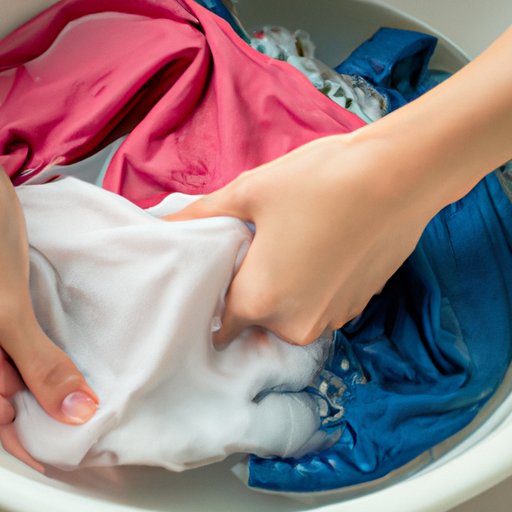
Introduction
Washing clothes by hand is no longer a common practice in today’s world of washing machines and dryers. But what if you don’t have a washer at home, or need to clean certain pieces that require special care and attention? Knowing how to wash clothes by hand is a valuable skill that can come in handy in various situations. This comprehensive guide will walk you through the step-by-step process of washing clothes by hand, discussing everything from water temperature and detergent selection to pre-treating stains and drying clothes.
Step-by-Step Guide to Washing Clothes by Hand
Step 1: Sort your clothes based on color and type. Fill a clean tub or basin with lukewarm water.
Step 2: Add detergent to the water. You can use a detergent designed specifically for hand washing, or a mild detergent like Woolite. Be sure to follow the package instructions for the amount of detergent to use.
Step 3: Add your clothes to the water. Make sure each piece is fully submerged and agitate the clothes by hand to create suds.
Step 4: Scrub any stained areas with a soft bristle brush or your fingers. Be careful not to damage delicate fabrics.
Step 5: Rinse your clothes under running water or in a different basin of clean water until the soap is fully removed.
Step 6: Gently squeeze out excess water from the clothes, being careful not to twist or wring them.
Step 7: Hang clothes to dry, preferably outdoors or in a well-ventilated area.
Water Temperature and Washing Clothes by Hand
Different types of clothes require different water temperatures for hand washing. For example, delicate fabrics like silk require cold water, while heavier fabrics like denim may require warm or hot water. Using the correct water temperature is crucial to prevent shrinking, stretching, or damage to your clothes.
To select the appropriate water temperature, refer to the care instructions on the label of your clothing. If no temperature is specified, err on the side of caution and use cool or lukewarm water.
Using Detergent for Washing Clothes by Hand
Using detergent is essential for cleaning your clothes effectively while washing them by hand. There are various types of detergents available in the market for hand washing clothes. Choosing the right detergent can make a significant difference in the quality of the wash and prolong the lifespan of your clothes.
When using detergent for hand washing clothes, it is essential to avoid using too much. Follow the package instructions for the recommended amount. Using too much detergent can leave residue on your clothes, leading to skin irritation and damaging the fabric.
Pre-Treating Stains Before Washing Clothes by Hand
Pre-treating stains is a crucial step before washing clothes by hand. It helps to ensure that the stains are removed effectively, leaving your clothes looking clean and fresh. Different stains require different treatment methods, and there are various stain removal products available in the market. Here are some tips on how to pre-treat common stains before washing clothes by hand.
– Blood: Rinse the stain with cold water as soon as possible. Soak the garment in cold water mixed with salt or vinegar for 15-30 minutes before washing.
– Grease/Oil: Apply dish soap or a grease-cutting solution to the stain and let it sit for a few minutes before washing.
– Wine: Blot the stain with a clean cloth to remove any excess wine. Mix hydrogen peroxide and dish soap and apply it to the stain before washing.
– Ink: Apply rubbing alcohol to the stain and blot with a clean cloth. Repeat the process until the stain is removed.
Drying Clothes After Washing Them by Hand
After washing clothes by hand, drying them correctly is crucial to prevent damage and extend the lifespan of your clothes. There are numerous methods for drying clothes after washing them by hand, including air-drying, line-drying, and using a clothes rack.
Air-drying is the most eco-friendly method of drying clothes and can be done by laying your clothes flat on a clean towel or hanging them over a shower rod or chair. Line-drying is also an eco-friendly option and can be done by hanging your clothes on a clothesline or drying rack. Avoid direct sunlight when drying clothes to prevent fading.
Washing Delicate Materials by Hand
Delicate materials like silk, cashmere, and other fragile clothes require special care and attention when washing by hand. To ensure your delicate pieces are washed correctly, follow these tips:
– Use cool water and a mild detergent designed specifically for delicate fabrics.
– Gently agitate the clothes by hand and soak for no more than 30 minutes.
– Rinse with cool water and gently squeeze out excess water.
– Lay the clothes flat on a clean towel to dry.
The Eco-Friendly Benefits of Handwashing Clothes
Washing clothes by hand is an eco-friendly alternative to using a washing machine. Handwashing clothes uses less water and energy, and it’s a great way to reduce your carbon footprint. Here are some tips to make handwashing clothes even more eco-friendly:
– Use natural detergents, such as soap nuts or baking soda, instead of chemical-filled options.
– Reuse water from handwashing clothes to water plants, flush toilets, or clean floors.
– Cut down on the frequency of doing laundry by spot-cleaning clothing and washing clothes less frequently.
Conclusion
Knowing how to wash clothes by hand is a valuable skill that can come in handy in various situations. Whether you want to save money, reduce your carbon footprint, or care for delicate fabrics, handwashing clothes is easy and effective when done correctly. Remember to follow the manufacturer’s instructions, use the right water temperature, and treat any stains before washing. Armed with these tips and tricks, you’re ready to tackle your handwashing laundry pile with confidence.





